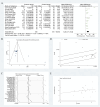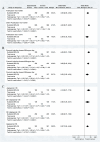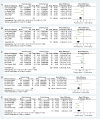Efficacy and safety of puerarin injection as an adjunctive therapy for chronic heart failure: a systematic review and meta-analysis
- PMID: 40391374
- PMCID: PMC12086430
- DOI: 10.3389/fphar.2025.1516059
Efficacy and safety of puerarin injection as an adjunctive therapy for chronic heart failure: a systematic review and meta-analysis
Abstract
Objective: Puerarin injection is used for the treatment of chronic heart failure (CHF). The objective of this study is to investigate the efficacy and safety of puerarin injection as an adjunct therapy for CHF through a meta-analysis and systematic review.
Methods: We conducted a comprehensive literature search across eight databases, including PubMed, Embase, Web of Science, and Cochrane Library, up to 1 March 2025, to identify the required randomized controlled trials (RCTs). Subsequently, we assessed the included studies according to the principles outlined in the Cochrane Handbook and performed a meta-analysis using RevMan 5.4 and Stata 12.0.
Results: A total of 29 RCTs were included, comprising 2,480 patients, with 1,251 in the Puerarin group and 1,229 in the control group. The meta-analysis demonstrated that puerarin injection combined with conventional medication significantly improved cardiac function parameters in chronic heart failure patients compared to pharmacotherapy alone, including left ventricular ejection fraction (MD = 6.22, 95% CI [3.11, 9.33], P < 0.01), cardiac output (MD = 0.45, 95% CI [0.35, 0.55], P < 0.01), and stroke volume (MD = 3.29, 95% CI [2.02, 4.57], P < 0.01), while reducing left ventricular end-diastolic diameter (MD = -0.83, 95% CI [-1.24, -0.42], P < 0.01). The combination therapy demonstrated both a significantly increased total effectiveness rate (RR = 1.26, 95% CI [1.21, 1.31], P < 0.01) and improved hemodynamic parameters, along with favorable modulation of oxidative stress markers evidenced by elevated superoxide dismutase, glutathione peroxidase, and catalase levels concomitant with reduced lipid peroxidation and malondialdehyde concentrations.
Conclusion: This meta-analysis suggests that adjunctive puerarin injection with conventional therapy may provide comprehensive benefits for chronic heart failure management, including improved clinical outcomes, enhanced cardiac function, attenuated ventricular remodeling, optimized hemodynamic performance, and reduced oxidative stress, while maintaining a safety profile comparable to conventional therapy. However, due to the suboptimal quality and some degree of heterogeneity in the existing evidence, there is a need for more high-quality studies to provide more reliable evidence for its future clinical application.
Systematic review registration: https://www.crd.york.ac.uk/PROSPERO/, identifier CRD42022371583.
Keywords: chronic heart failure; meta-analysis; puerarin injection; systematic review; traditional Chinese medicine.
Copyright © 2025 Fan, Yang, Wang, Zong, Qu, Wang, Zhang and Li.
Conflict of interest statement
The authors declare that the research was conducted in the absence of any commercial or financial relationships that could be construed as a potential conflict of interest.
Figures











Similar articles
-
Efficacy and safety of Puerarin injection on acute heart failure: A systematic review and meta-analysis.Front Cardiovasc Med. 2022 Jul 25;9:934598. doi: 10.3389/fcvm.2022.934598. eCollection 2022. Front Cardiovasc Med. 2022. PMID: 35958424 Free PMC article.
-
A Systematic Review and Meta-Analysis on the Efficacy of Puerarin Injection as Adjunctive Therapy for Unstable Angina Pectoris.Front Cardiovasc Med. 2022 Feb 24;9:763567. doi: 10.3389/fcvm.2022.763567. eCollection 2022. Front Cardiovasc Med. 2022. PMID: 35282378 Free PMC article.
-
Effect of Astragalus membranaceus on left ventricular remodeling in HFrEF: a systematic review and meta-analysis.Front Pharmacol. 2024 Jan 12;15:1345797. doi: 10.3389/fphar.2024.1345797. eCollection 2024. Front Pharmacol. 2024. PMID: 38283626 Free PMC article.
-
Efficacy and safety of Shen Gui capsules for chronic heart failure: a systematic review and meta-analysis.Front Pharmacol. 2024 Apr 10;15:1347828. doi: 10.3389/fphar.2024.1347828. eCollection 2024. Front Pharmacol. 2024. PMID: 38659585 Free PMC article.
-
Sodium tanshinone ⅡA sulfonate injection as adjunctive therapy for the treatment of heart failure: A systematic review and meta-analysis.Phytomedicine. 2022 Jan;95:153879. doi: 10.1016/j.phymed.2021.153879. Epub 2021 Dec 4. Phytomedicine. 2022. PMID: 34906894
References
-
- Cai Y., Liu Li. (2006). Clinical observation of puerarin injection in the treatment of chronic cor pulmonale heart failure. J. Pharm. Epidemiol. (4), 197–199.
Publication types
LinkOut - more resources
Full Text Sources

